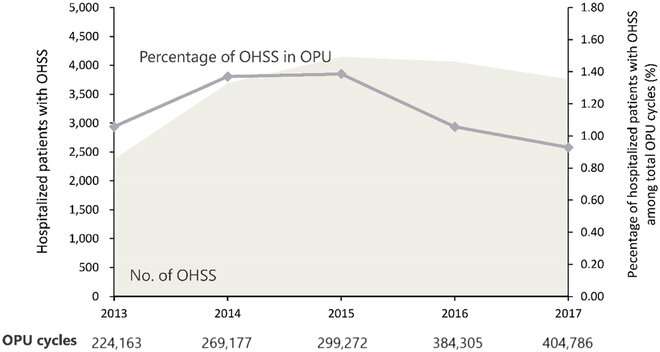This article has been reviewed according to Science X's editorial process and policies. Editors have highlighted the following attributes while ensuring the content's credibility:
fact-checked
proofread
The first report on the incidence of moderate and severe ovarian hyperstimulation syndrome in China

Moderate and severe ovarian hyperstimulation syndrome (OHSS) developed in 1.14% of Chinese women of reproductive age between 2013 and 2017. Moreover, women under 35 years of age receiving assisted reproductive technology (ART) should be monitored for OHSS more closely compared with other age groups.
These findings were concluded from the first report on the incidence of moderate and severe OHSS in China recently published in Health Data Science.
OHSS constitutes the most severe iatrogenic complication of ovulation induction in ART, whose incidence represents ART risk. However, its incidence had been poorly known in China until the Peking University Third Hospital (PUTH) team threw light on the issue.
"Our purpose is to characterize the incidence of moderate and severe OHSS among Chinese women. It is the first national report of the Chinese population," shared Jie Qiao, Academician of the Chinese Academy of Engineering and Professor at PUTH. "We believe our findings are very helpful for front-line clinicians to better understand the burden of OHSS."
"The national datasets Hospital Quality Monitoring System (HQMS) and National ART Management Information System (NARTMIS) were used to investigate the incidence of moderated and severe OHSS in China," said Xiaoyu Long, Associate Professor at PUTH. "We also reported the annual incidence by the calendar year in China between 2013 and 2017."
"We reported the incidence of moderate and severe OHSS among Chinese women of productive age as 1.14% from 2013 to 2017. The annual incidence trended towards decline during the study period," explained Danni Zheng, Management research assistant at PUTH. "Women aged 26-30 years and 31-35 years accounted for about 80% of new OHSS cases during this period, suggesting that women aged 26-35 years were at high risk of OHSS."
The incidence of moderate and severe OHSS and the preponderance of women aged 26-35 years revealed in the study were consistent with previous reports. Moreover, the downward trend may have been driven by the application of the standardized protocol, antagonist regimens, and extensive adoption of oocyte cryopreservation.
With the wide application of ART and the presence of related comorbidities, OHSS is a common complication during ovulation induction. Therefore, knowing the disease burden and identifying the high-risk group is indispensable for improving the health outcomes of the women undergoing ART. "We plan to investigate these health issues when the data with finer granularity are available," said Prof. Qiao.
More information: Danni Zheng et al, The Incidence of Moderate and Severe Ovarian Hyperstimulation Syndrome in Hospitalized Patients in China, Health Data Science (2023). DOI: 10.34133/hds.0009



















